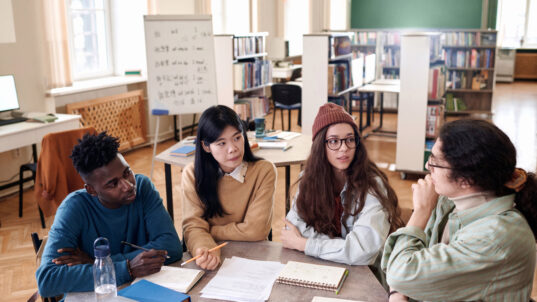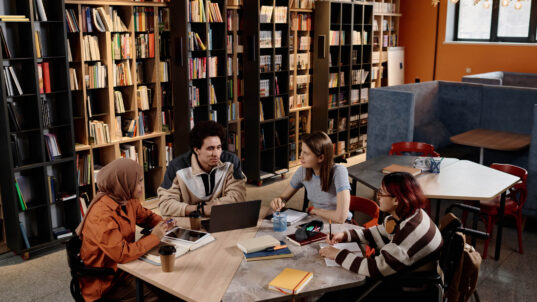An interview with Philomena Krosmico
Philomena started with a simple question: “How have you made a difference this week, big or small?” In this story, she describes how she adapted the Interactivity Foundation’s “Path to Purpose: Making a Difference Interactive Journal” to help support youth preparing for Catholic Confirmation.
The silence usually stretches on in my Sunday School class when I pose this kind of question, complete with nervous avoidance of direct eye contact with me. But on this first day of discussions, something about the question struck them as worthy of an answer. A hand hesitantly shot up, then another, and another. Even Michael, who usually sat with his arms crossed and a stoic expression, leaned forward, interested in the stories waiting to be told.
As each student shared their experiences, a sense of purpose filled the room. There was Sarah, who stood up to a bully at school; David, who was a camp counselor during the summer; and Michael, the usually quiet observer, who revealed how he’d helped his sports team win a game. They now saw themselves as more than just kids; they were changemakers. When they began to talk about how people view them in a positive light for their acts of kindness, my students got emotional.
The “Path to Purpose Interactive Journal” encouraged the students to reflect on their experiences and envision their lives in milestones—graduation, college, marriage— building an understanding that now was the time they needed to think about making a difference. What was even more encouraging was that I could tell they weren’t just thinking about things in terms of how they could get attention but instead how they could genuinely help others.
My students shared the following insights from their experiences with the interactive journal. The students indicated the most impactful stories for them, and I was impressed with how seriously they took each one.
What was the most important thing you learned about making a difference from these Sunday discussions?
“I learned that when you make a difference, it not only affects the people you helped but makes you feel better and helps you get closer to God.”
“It showed me how important faith was to these people and made me become closer to God.”
“The most important thing I learned was that even the smallest acts can add up and make a difference.”
Their answers to the reflection questions were an excellent barometer for me to better understand how much of the lessons they were internalizing. I overheard two of them talking about visiting the Two Blind Brothers website to check it out after hearing the story from the Path to Purpose journal about how the boys had overcome their suffering and used it to help others. Another impactful story was of Carlo Acutis, an Italian teenager who was informally known as “God’s Influencer” for using his computer skills to spread the Catholic faith and is set to become the first saint of the Millennial generation. Carlo Acutis died of leukemia in 2006 at the age of 15, but before his untimely death, he used his computer skills to create an online database of Eucharistic miracles around the world and is now on the path to sainthood.
Another heartwarming moment for me came when my students latched onto Diamond’s story, where she helped her friend Arianna, who had an eating disorder. Initial reactions were they really couldn’t do anything to help in a situation like that. It then inspired Johnny to talk about a time when he saw bruise marks on his friend, and he talked to the principal at school. Discovering that we all have crosses to carry and Jesus is counting on us to be his eyes, hands and feet here on earth. Diamond was brave, she put herself out there to find help for Arianna. Even though Arianna wasn’t receptive, Diamond knew it was the right thing to do. Sometimes, taking the extra steps to make a difference can make you unpopular or second-guess yourself, but in the end, it is better than regretting that you didn’t try to help. The honest discussions between them at the beginning of the discussion, comments like “I am only in 8th grade, what can I do?” to self-discover what they can do by talking it out as a group, sharing similar experiences, and encouraging each other. One young lady spoke about a situation with a friend who threatened to hurt herself. She expressed she wanted to help but was unsure of who to trust. She said she now sees what she could do and is thankful her situation didn’t turn out as bad as it could have. I was very pleased with their interactions, engagement, and respect for each other’s stories. I could see them learning and growing right in front of me. Throughout the weekly lessons, I observed how their non-verbal cues played out. Heads nodded in agreement, eyes welled with emotion, and genuine smiles came across their faces. They were engaged, not just by the age-appropriate material, but by the power they knew they possessed as changemakers.
When they learned about a man who sold all he owned to give to the poor in Cambodia during the same week our Missions Priest visited the church and spoke of very similar circumstances in his life, I could tell the students really “got” it. I was able to adapt the journal to include applicable scripture and written prayers, and I was grateful for the option to customize the lessons each week. As the last week of classes came to a close, I knew something special had transpired. I observed how they came together as a group and became comfortable sharing with each other.
My students walked out that last day until fall not just with a takeaway from a story but with the knowledge that even they, at their young age, could be agents of change; it was a spark, a call to action.



